In his classic story of spies and crossed fates, “The Garden of Forking Paths,” Jorge Luis Borges imagines a labyrinthine manuscript, “a growing, dizzying web of divergent, convergent, and parallel times.” The fictional book of the story is unfinished, not only because its author is murdered before he can complete it, but also because its form is necessarily infinite, encompassing all timelines generated by every decision of every character: an inescapable maze.
Yet the structures of some real books resemble what Borges had in mind. Not only do these novels challenge our understanding of narrative linearity, they invite us to participate in the making of the story, to play along with each reading. And just as with a well-built maze, getting lost in each of these books can be a lot of fun.
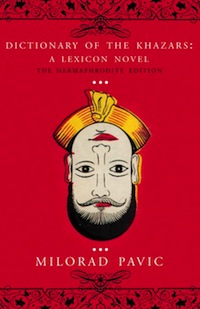 Milorad Pavić, The Dictionary of the Khazars
Milorad Pavić, The Dictionary of the Khazars
Deserving of consideration as a classic of 20th century fantasy, this novel features a mysterious sect of dream hunters, games with time and mirrors, and a language preserved by birds. Something like an analog Wikipedia entry—though published a year before the invention of the Web—the book is actually three fictional dictionaries, each containing a different perspective on a playfully mythologized version of the Khazars, a semi-nomadic people who once occupied land between the Caspian Sea and the Black Sea. The narrative threads span continents, centuries, and dreams; to follow them is to play at being both a folklorist and a treasure hunter.
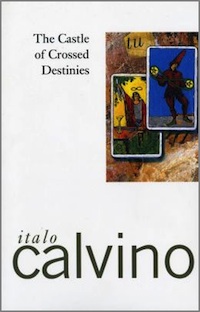 Italo Calvino, The Castle of Crossed Destinies
Italo Calvino, The Castle of Crossed Destinies
When asked to write a brief booklet to accompany the reproduction of a fifteenth century deck of cards, the Italian author “was tempted by the diabolical idea of conjuring up all the stories that could be contained in a tarot deck.” The result is this novel, which he wrote by laying out all the cards in a grid and then reading them from top to bottom, side to side. The narrators of the resulting linked stories—mute from some unknown trauma—tell their tales of love, loss, and adventure using cards rather than words.
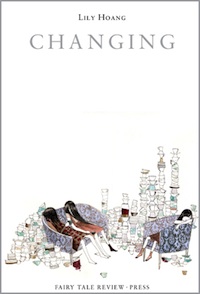 Lily Hoang, Changing
Lily Hoang, Changing
Published by the reliably excellent Fairy Tale Review Press, this novel is modeled after the I Ching, the ancient Chinese divination system. At the back of the book, the author includes cut-outs of a paper cup and numbered tiles, which readers may use to select chapters at random; the chapters are shaped like the hexagrams of the I Ching. Weaving together nursery rhymes, oracular statements, and a coming-of-age tale, Hoang fuses storytelling and fortunetelling to original, often devastating effect.
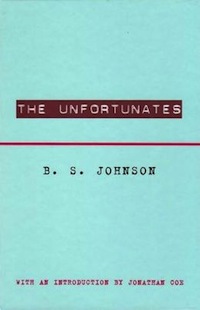 B.S. Johnson, The Unfortunates
B.S. Johnson, The Unfortunates
This book comes in the form of twenty-seven separately bound sections, packed together in a single box. One section is labeled “FIRST,” another is “LAST,” and the rest are meant to be shuffled. The largely autobiographical story is about a man contemplating the death of a beloved friend while on a sportswriting assignment. What’s remarkable about the book is how its shuffled structure mirrors the rambling, leaping movements of the human mind, “the circuit-breakers falling at hazard, tripped equally by association and non-association, repetition….”
 Nanni Balestrini, Tristano
Nanni Balestrini, Tristano
Another shuffleable novel, but this one you don’t have to shuffle, because every copy of the book has been printed with the pages in a different order (I’m the proud owner of version #11476). A love story—and a reimagining of the Tristan and Isolde legend—the novel blurs the identities of the main characters (both referred to as “you” and “I”and sometimes “C”) along with geographical place names (also often “C”) to the point where the story gathers itself up into a dreamlike whirl of cigarettes, taxis, telephone calls, and frustrated revolution. “A book is endless books and each of them is a slightly different version of you.” So reads an emblematic line on page 8 of my copy, but in yours it will probably be someplace else.
 Edward Gorey, “The Helpless Doorknob: A Shuffled Story”
Edward Gorey, “The Helpless Doorknob: A Shuffled Story”
Now to cheat a bit. First, this is entry #6. Second, this is technically a story, not a book. Third, I only just found out about “The Helpless Doorknob,” and I’ve never held a copy in my hands. I’ve seen it online, though, so I know that each entry in this deck of twenty cards features someone whose name starts with A, most of whom are doing something terrible or at least something terribly suspicious. In any case, I can’t leave Edward Gorey off this list, because so many of his little books are labyrinths without solutions. Fellow admirers of his work will likely think of The Awdrey-Gore Legacy, which is a classic murder mystery broken down into its constituent parts, or The Fantod Pack, a fortunetelling deck which may reward its readers with “mumbling sickness,” “a secret enemy,” or “an accident in a stadium.” Each may be read dozens of different ways, but I recommend a hundred or more visitations.
Jedediah Berry is the author of the Crawford Fantasy Award-winning novel, The Manual of Detection. His story-in-cards, “The Family Arcana,” currently being funded on Kickstarter, will be published by Ninepin Press.










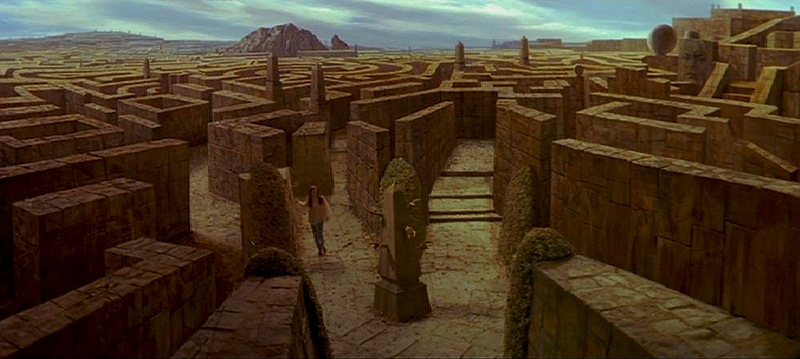
Also, nearly anything by Tim Powers or John Crowley.
You can’t have a list like this and not include John Barth. Pick Chimera from early Barth, or The Last Voyage of Somebody the Sailor from middle Barth. Both include stories within stories within stories, and the reader can pop to the surface or go in deep.
No House of Leaves? I think that’s more a “labyrinth” than most of these “shuffle” books.
You forgot House of Leaves. If any book is a labyrinth, that’s the one.
I’d add Tourists by Lisa Goldstein.
The first one that came to my mind is <i>Dhalgren</i>, although I’d have to agree that Dictionary of the Khazars is the most labyrinthian I know. When I read it, the dictionary entries often refer you to other entries in the other sections, with the result that I read the book skipping back and forth across the three dictinoaries. I’ve never had anything quite like that reading experience since.
Roundly, meanderingly, yes-ly … the Dictionary of the Khazars and the Castle of Crossed Destinies. :D
But some of these that I hadn’t heard about sound wonderful too.
Geoff Ryman’s lovely 253— also available in print, but easier to get lost in online. I’m guessing that the Calvino (which I haven’t read) may have been an influence.
I love Ryman’s 253—thanks for suggesting it. My omission of Danielewski is probably due to my starting with one idea (shuffleable books), then trying to describe their effect with another (labyrinths). Agreed, of course, that House of Leaves—or most any of his other works—belongs here as well.
Tourists sounds amazing. Will check it out.
Hopscotch by Julio Cortázar. Although I read it as it’s printed apparently you are supposed to jump from one chapter to another – as the title implies. A must!
The two volumes of The Orphan’s Tales (In the Night Garden and In the Cities of Coin and Spice) by Catherynne M Valente seem fairly labyrinthine: They’re a thick weaving of different levels of stories being told by different characters within other stories
Possibly, Kate Atkinson ‘s Life After Life. One life, one starting point, but a whole bunch of different paths through. And if the path comes to a dead end, you go back and try another.
I would add House of leaves as well it’s the very defention of a babyrinth
Not forgetting S.by J.J. Abrams, Doug Dorst..
What, no Gene Wolfe? Come on! The man wrote A Solar Labyrinth for heaven’s sake. Not to mention what I think of as the ultimate labyrinthine novel/three interweaved stories: The Fifth Head of Cerberus. Seiously though, good list with one exception.
I’d add The Saragossa Manuscript by Jan Potocki. And another rec for Tourists!
I agree with @6, Samuel Delaney’s Dahlgren was the first book I thought of. About as labyrinthy as a book could be.
Add me to the many “but, House of Leaves!”
What about “Hopscotch” by Julio Cortazar?One of the most amazing books I’ve ever read!
What about Michel Butor ?
Rayuela by Julio Cortázar is not only one of the biggest masterpieces of Latin America, it also represents perfectly this arcticle. It’s more popular than half of these books, too. BUMMED to see how once again, great latinx autors are just completely overlooked.
Chris Ware’s Building Stories, which comes in a box, and contains comics in various formats (including loose-leaf strips of paper, harcover books of different dimensions, a “Golden Book”-like children’s-book binding containing a very not-for-kids story). All the stories are united by their setting, one apartment building in Chicago. The reader has to work to put them together in time and space, literally, with his/her hands, and this experience calls to mind the architecture of buildings and the time-and-space architecture of the comics medium.
What about Pale Fire by Nabokov?
You’re supposed to jump chapters according to suggestions on the text or your own will. Also its three stories inside the footnotes of a poem that is another story.
Dan Slott (current writer of Amazing Spider-Man) wrote a Ren & Stimpy comic “Masters of Time & Space”, a time travel story that let the reader make choices. Some of the scenes had different meanings depending on how you got there– one of the possible paths through the story was 10 pages longer than the comic book itself!
Oh, Italo Calvino’s The Castle of Crossed Destinies is absolutely entertaining!
Without giving too much away there’s a labyrinth/maze which turns up in Marjorie M Liu’s “Hunter Kiss” novels.
I think what we learn from this comment thread is that “labyrinth” is a poor term for the common connector between the five books listed.